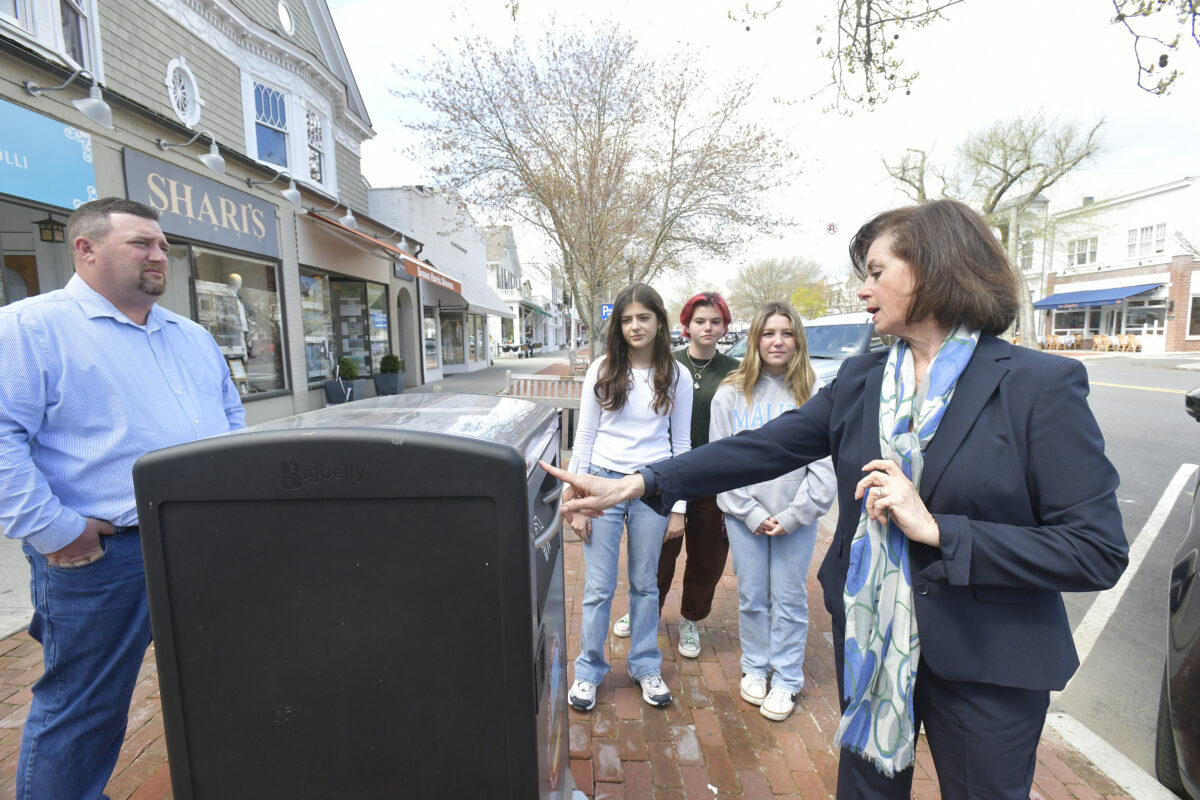
It was a long time coming, but 10 Bigbelly solar-powered trash compacting stations have finally been installed on Main Street in Southampton Village.
The idea and impetus to install the Bigbelly trash cans came to the Southampton Village Board in 2020 from a group of students at the Southampton Intermediate School.
The students — Madalyn Wik, Xanthi Lazaraki, Riley Moredock, Katie Terry, and Bea Fino Morofogen — are now juniors but were eighth-graders at the time. They were interested in finding ways to make the village more environmentally friendly. They spent time brainstorming ways they could achieve that goal while meeting together over Zoom as part of the school’s mock trial club, led by teacher Ken Sisco.
His wife, Natalie Sisco — a former teacher and advisor with the girls empowerment nonprofit i-tri — suggested they look into the solar trash compacting stations.
Natalie Sisco, who described the five students as “go-getters,” said they took the idea and ran with it, doing research on the compacting stations and then putting together a slide show presentation which they presented over Zoom at a Village Board meeting.
The trustees were sold, but supply chain issues caused by the pandemic greatly delayed the rollout of the compacting stations until earlier this spring.
Southampton Village Deputy Mayor Gina Arresta, who is also the liaison to the village’s department of public works, said she’s thrilled the cans are finally in the street, and touted their many benefits.
Aside from the environmentally friendly aspect of solar power usage, the stations are closed containers, meaning trash cannot overflow and invite pests like seagulls or create any unpleasant sights or smells. Because the stations compact the trash, they need to be emptied less frequently, saving village workers time and saving the village money, because they require less trips to cart trash to transfer stations. DPW workers are set up to receive a ping on their devices when the cans are full, meaning they do not have to constantly monitor whether they need to be emptied.
One additional feature that has been included for the stations that Arresta said residents have told her they really appreciate is a foot pedal on each station, so people can dispose of trash in a hands-free manner.
“That’s a big feature that people really love,” she said, adding that “for the most part,” the new stations have been well-received.
The 10 cans that have been placed along Main Street represent the first phase of a planned rollout of the stations throughout the village. Arresta said more stations will be installed on Jobs Lane and Hampton Road next, although the timetable for when that will happen remains up in the air.
The determination of where to place the 10 Bigbelly stations on Main Street was left up to the company itself, Arresta said. She said the old trash cans were removed because they required a lot of maintenance on the part of the DPW. She said that the company advised putting the cans near crosswalks, which is where people have a tendency to seek out a trash can, and added that they did not want to place the stations in front of any restaurants that have outdoor dining, although there was a communication to the board ahead of the Tuesday night work session from the Golden Pear, which sits on the corner of Main Street and Hampton Road, asking for a trash can to be placed outside their store again.
Despite that, Arresta said the feedback she’s received about the new Bigbelly containers has been overwhelmingly positive.
“This is a much sleeker, much cleaner look,” she said. “In the long run, it’s saving us time and money. The No. 1 thing is they’re better for the environment.
“It’s all part of our ongoing effort to keep the downtown more clean and beautiful,” she continued. “This is my goal, to get Southampton Village as environmentally friendly as possible.”
That same goal was what motivated the five Southampton students to suggest the idea for the receptacles in the first place.
“We all obviously love our town and we love the beach and nature of Southampton Village. It’s such a beautiful place to live,” Terry said. “But we noticed a lot of trash in the village, and we wanted to find a sustainable solution to that.”
In addition to knowing they made a positive impact, Terry said it was gratifying to know that they could go before the Village Board and have their ideas and suggestions valued and taken seriously.
“It’s really cool and it feels really great that we were able to have such a positive impact for the town we love,” she said. “It’s great to see that people can listen to each other, and it’s great to know our voices were heard.”